英语语法 名词变复数 详细完整版讲解及练习
英语可数名词变复数的规则(附练习及答案)
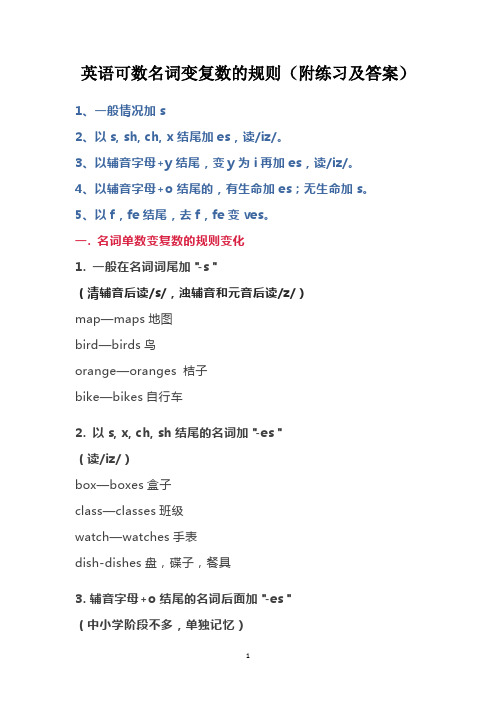
英语可数名词变复数的规则(附练习及答案)1、一般情况加s2、以s, sh, ch, x结尾加es,读/iz/。
3、以辅音字母+y结尾,变y为i再加es,读/iz/。
4、以辅音字母+o结尾的,有生命加es;无生命加s。
5、以f,fe结尾,去f,fe变ves。
一. 名词单数变复数的规则变化1. 一般在名词词尾加"-s"(清辅音后读/s/,浊辅音和元音后读/z/)map—maps地图bird—birds鸟orange—oranges 桔子bike—bikes自行车2. 以s, x, ch, sh结尾的名词加"-es"(读/iz/)box—boxes盒子class—classes班级watch—watches手表dish-dishes盘,碟子,餐具3. 辅音字母+o结尾的名词后面加"-es"(中小学阶段不多,单独记忆)tomato—tomatoes西红柿potato—potatoes土豆hero—heroes英雄negro—negroes黑人辅音字母+o结尾的名词后面加"-s"(一般为外来词或者缩写词)photo—photos相片kilo—kilos千克元音字母+o结尾的名词后面加"s" radio—radios收音机zoo—zoos动物园4. 以辅音字母加y结尾的名词,变y为i加"-es " baby—babies婴儿family—families家庭party—parties聚会以元音字母加y结尾的名词直接加"-s" boy—boys男孩toy—toys 玩具5. 以fe或f结尾的名词,把fe或f变为v加"-es"(读/vz/,数量不多,单独记忆)knife—knives小刀wife—wives妻子leaf—leaves树叶直接加-sroof—roofs房顶proof—proofs证据chief—chiefs首领两种都可以handkechief手绢—handkerchiefs / handkerchieves二. 名词单数变复数的不规则变化1. child—children 孩子foot—feet 脚tooth—teeth 牙齿mouse—mice 老鼠man—men 男人woman—women 女人注意:与man 和woman构成的合成词,其复数形式也是-men 和-women,例如:an Englishman—two Englishmen 但German不是合成词,故复数形式为Germans;Bowman是姓,其复数是the Bowmans(鲍曼一家)。
(精)小学英语名词变复数讲解加练习

语法(一)名词热身练习题I _____________ this_____________ that _____________ watch _____________child _____________ photo _____________ diary _____________ day_____________ foot_____________ book_____________ dress _____________ tooth_____________sheep _____________ box_____________ strawberry _____________ thief _____________yo-yo_____________ peach_____________ sandwich _____________ man_____________woman_____________ paper_____________ juice_____________ water_____________milk_____________ rice_____________ tea_____________注意be 动词遇到名词时的运用: 单数名词用is, 复数名词全用are.名词单复数讲解及练习1.(1)名词可以分为可数名词和不可数名词,不可数名词没有单复数,一律看作单数。
(2)可数名词的单数前什么时候用a,什么时候用an?答:以元音音标(或音素)开头的用an,以辅音音标(或音素)开头的用a。
(注意:我们看的是音标(或音素),而不是元音字母.)③以辅音字母加y结尾的名词,变y为i再加es,读[iz];以元音字母加y结尾的名词直接在词尾加s。
如:baby —— babies , boy —— boys④以f、fe结尾的名词变f、fe为ves, 如:wolf——wolves wife —wives life —lives knife—knives⑤以o结尾的名词加es 的有:potatoes, tomatoes, Negroes其余的,加s。
名词变复数规则及练习(含五篇)

名词变复数规则及练习(含五篇)第一篇:名词变复数规则及练习名词一.名词的数名词分可数名词和不可数名词两大类 1.不可数名词A.不可数名词没有单复数之分,包括专有名词抽象名词和物质名词例如:抽象名词health 健康advice 建议物质名词water 水air 空气wood 木头专有名词America 美国China 中国Mike 人名B.表示学科名称以ics 结尾的名词常做单数例如:physics 物理mathematics 数学2.可数名词可数名词有单数和复数之分A.一般情况下在词尾直接加 s例如: tables 桌子books 书friends 朋友 B.以 s,x,ch,sh结尾的名词后加 es 例如: bus-buses 公车box-boxes 盒子brush-brushes 刷子watch-watches 手表例外:stomach-stomachs 胃C.一些以辅音字母加o结尾的单词加es 例如: hero-heroes 英雄tomato-tomatoes 西红柿potato-potatoes 土豆口诀:黑人和英雄喜欢土豆和西红柿Negroes and heroes like potatoes and tomatoes.很多以o结尾的单词变复数时只加s,pianos 钢琴photos 照片zoos 动物园等 D.以辅音字母加y结尾的单词,把y变为i加es。
例如: family-families 家庭factory-factories 工厂country-countries 国家E.一些以f和fe结尾的单词把f或fe变成v再加es。
例如:leaf-leaves 叶子wife-wives 妻子knife-knives 刀life-lives 生命妻子拿刀去杀狼,小偷看见发了慌,躲在架后保己名,半片树叶遮目光。
wife 妻子knife 刀wolf 狼thief 小偷shelf 架子 self 自己half 一半leaf 叶子 F.一些不规则变化例如:foot-feet 脚goose-geese鹅tooth-teeth 牙齿 man-men 男人 woman-women 女人mouse-mice 老鼠child-children 孩子F.还有一些单词单数和复数相同,单复同形。
英语名词单数变复数及练习
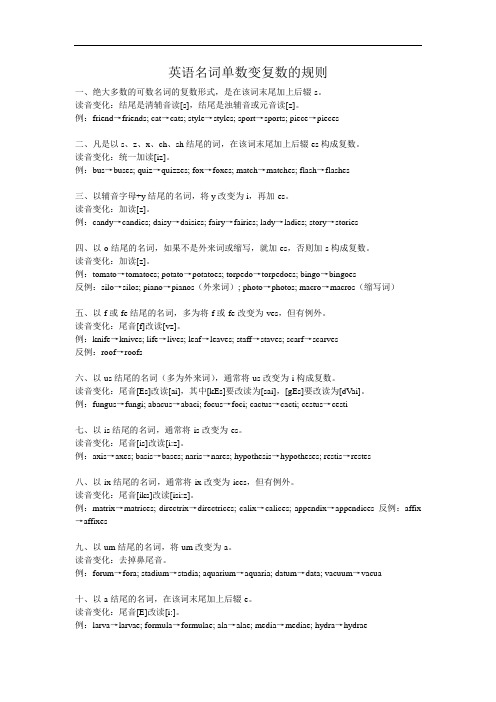
英语名词单数变复数的规则一、绝大多数的可数名词的复数形式,是在该词末尾加上后辍-s。
读音变化:结尾是清辅音读[s],结尾是浊辅音或元音读[z]。
例:friend→friends; cat→cats; style→styles; sport→sports; piece→pieces二、凡是以s、z、x、ch、sh结尾的词,在该词末尾加上后辍-es构成复数。
读音变化:统一加读[iz]。
例:bus→buses; quiz→quizzes; fox→foxes; match→matches; flash→flashes三、以辅音字母+y结尾的名词,将y改变为i,再加-es。
读音变化:加读[z]。
例:candy→candies; daisy→daisies; fairy→fairies; lady→ladies; story→stories四、以-o结尾的名词,如果不是外来词或缩写,就加-es,否则加-s构成复数。
读音变化:加读[z]。
例:tomato→tomatoes; potato→potatoes; torpedo→torpedoes; bingo→bingoes反例:silo→silos; piano→pianos(外来词); photo→photos; macro→macros(缩写词)五、以-f或-fe结尾的名词,多为将-f或-fe改变为-ves,但有例外。
读音变化:尾音[f]改读[vz]。
例:knife→knives; life→lives; leaf→leaves; staff→staves; scarf→scarves反例:roof→roofs六、以-us结尾的名词(多为外来词),通常将-us改变为-i构成复数。
读音变化:尾音[Es]改读[ai],其中[kEs]要改读为[sai],[gEs]要改读为[dVai]。
例:fungus→fungi; abacus→abaci; focus→foci; cactus→cacti; cestus→cesti七、以-is结尾的名词,通常将-is改变为-es。
小学英语名词单复数变化及习题
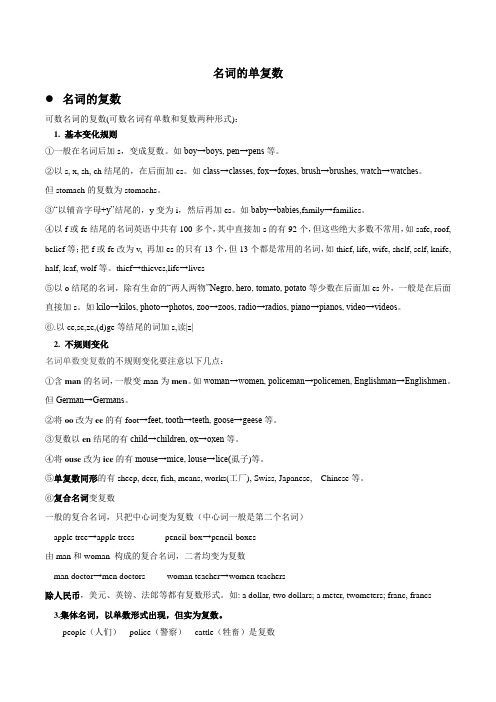
名词的单复数名词的复数可数名词的复数(可数名词有单数和复数两种形式):1. 基本变化规则①一般在名词后加s,变成复数。
如boy→boys, pen→pens等。
②以s, x, sh, ch结尾的,在后面加es。
如class→classes, fox→foxes, brush→brushes, watch→watches。
但stomach的复数为stomachs。
③“以辅音字母+y”结尾的,y变为i,然后再加es。
如baby→babies,family→families。
④以f或fe结尾的名词英语中共有100多个,其中直接加s的有92个,但这些绝大多数不常用,如safe, roof, belief等;把f或fe改为v, 再加es的只有13个,但13个都是常用的名词,如thief, life, wife, shelf, self, knife, half, leaf, wolf等。
thief→thieves,life→lives⑤以o结尾的名词,除有生命的“两人两物”Negro, hero, tomato, potato等少数在后面加es外,一般是在后面直接加s。
如kilo→kilos,photo→photos, zoo→zoos, radio→radios, piano→pianos, video→videos。
⑥.以ce,se,ze,(d)ge等结尾的词加s,读|z|2. 不规则变化名词单数变复数的不规则变化要注意以下几点:①含man的名词,一般变man为men。
如woman→women, policeman→policemen, Englishman→Englishmen。
但German→Germans。
②将oo改为ee的有foot→feet, tooth→teeth, goose→geese等。
③复数以en结尾的有child→children, ox→oxen等。
④将ouse改为ice的有mouse→mice, louse→lice(虱子)等。
英语名词变复数的规则及练习题
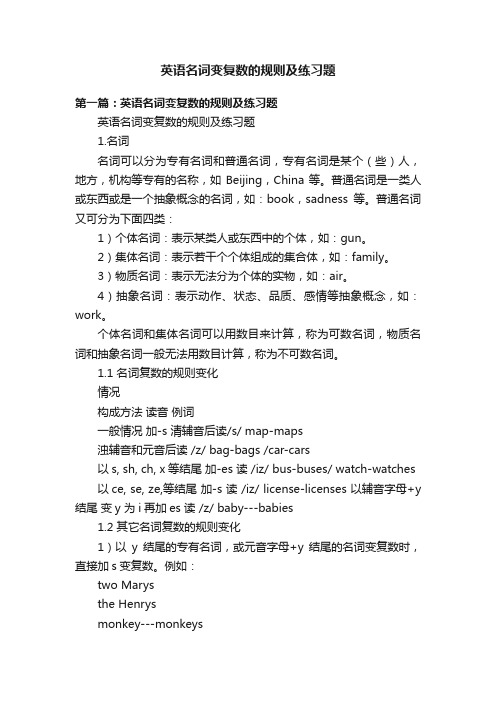
英语名词变复数的规则及练习题第一篇:英语名词变复数的规则及练习题英语名词变复数的规则及练习题1.名词名词可以分为专有名词和普通名词,专有名词是某个(些)人,地方,机构等专有的名称,如Beijing,China等。
普通名词是一类人或东西或是一个抽象概念的名词,如:book,sadness等。
普通名词又可分为下面四类:1)个体名词:表示某类人或东西中的个体,如:gun。
2)集体名词:表示若干个个体组成的集合体,如:family。
3)物质名词:表示无法分为个体的实物,如:air。
4)抽象名词:表示动作、状态、品质、感情等抽象概念,如:work。
个体名词和集体名词可以用数目来计算,称为可数名词,物质名词和抽象名词一般无法用数目计算,称为不可数名词。
1.1 名词复数的规则变化情况构成方法读音例词一般情况加-s 清辅音后读/s/ map-maps浊辅音和元音后读 /z/ bag-bags /car-cars以s, sh, ch, x等结尾加-es 读 /iz/ bus-buses/ watch-watches 以ce, se, ze,等结尾加-s 读 /iz/ license-licenses 以辅音字母+y 结尾变y 为i再加es 读 /z/ baby---babies1.2 其它名词复数的规则变化1)以y结尾的专有名词,或元音字母+y 结尾的名词变复数时,直接加s变复数。
例如:two Marysthe Henrysmonkey---monkeysholiday---holidays2)以o 结尾的名词,变复数时:a.加s,如: photo---photospiano---pianosradio---radioszoo---zoos;b.加es,如:potato--potatoestomato--tomatoesc.上述a和b两种方法均可,如zero---zeros / zeroes。
3)以f或fe 结尾的名词变复数时:a.加s,如: belief---beliefsroof---roofssafe---safesgulf---gulfs;b.去f,fe 加ves,如:half---halvesknife---knives leaf---leaveswolf---wolveswife---wiveslife---livesthief---thieves;c.上述a和b两种方法均可,如handkerchief: handkerchiefs / handkerchieves。
小学英语名词变复数讲解和练习

小学英语名词变复数讲解和练习公司内部档案编码:[OPPTR-OPPT28-OPPTL98-OPPNN08]一、名词名词可以分为可数名词与不可数名词,其中可数名词具有单、复数(de)形式;而不可数名词没有复数形式.1. 从单数复数,变形规则如下:1.一般情况下,直接加-s,如:book-books, bag-bags, cat-cats, bed-beds2.以s. x. sh. ch结尾,加-es,如:bus-buses, box-boxes, watch-watches3.以“辅音字母+y”结尾,变y为i, 再加-es,如:family-families(家庭), strawberry-strawberries(草莓)4.以“f或fe”结尾,变f或fe为v, 再加-es,如:knife-knives5.不规则名词复数:man-men, woman-women, policeman(男警察)-policemen, policewoman(女警察)-policewomen, mouse-micechild(孩子)-childrenfoot-feet,. tooth-teethfish-fish, sheep(羊)-sheep people-people, Chinese-Chinese, Japanese-Japanese,当people后加上s时即peoples表示“民族”例如:There are 56 peoples in China. 中国有56个民族.2.以下词为常为不可数名词,他们(de)复数形式就是他们本身.Water(水) milk(牛奶) tea(茶) rice(米饭) orange(橙汁)juice(果汁)bread(面包)练习题写出下列各词(de)复数I _________this ___________that___________watch _______child _______photo ________diary _________day________ foot________ book_______ dress ______________tooth_______ sheep ______box_______ strawberry _____________thief _______yo-yo ______ peach______ sandwich _______________man______ woman_______ paper_______ juice____________________ water________ milk________ rice__________ tea_______________-注意be 动词遇到名词时(de)运用: 单数名词用is, 复数名词全用are.名词单复数讲解及练习名词单复数(1)名词可以分为可数名词和不可数名词,不可数名词没有单复数,一律看作单数.(2)可数名词(de)单数前什么时候用a,什么时候用an答:以元音音标(或音素)开头(de)用an.以辅音音标(或音素)开头(de)用a.注意:我们看(de)是音标(或音素),而不是元音字母.一、选择a或an或不填(用/表示)pen bagapple big applebanana orange oranges orange pen(3)可数名词(de)变化规则:①一般在词尾加s,如:books,bags,fruits.加s之后(de)读音②以s、x、ch、sh结尾(de)名词加es,③以辅音字母加y结尾(de)名词,变y为i再加es,读[iz];以元音字母加y结尾(de)名词直接在词尾加s. 如:baby —— babies④以f、fe结尾(de)名词变f、fe为ves,如:wolf [wulf] 狼——wolves wife(妻子)—life(生命)— knife —⑤以o结尾(de)名词加es (de)有:如:zoo——zoos photo——photos(4)名词复数(de)不规则变化:man—men男人woman[wumEn]—women [5wimin] 女人tooth [tu:W]—teeth [ti:W] 牙齿foot [fut]—feet [fi:t] 脚,英尺 goose [gu:s]—geese [gi:z] 鹅mouse [maus] —mice [mais] 老鼠②child [tFaild]—children [5tFildrEn] 孩子③单复同形(de)名词有:chinese [5tFaini:z] 中国人Japanese [7dVApE5ni:z]日本人sheep [Fi:p] 绵羊 deer [diE] 鹿 fish [fiF] 鱼注意:fish①当一条鱼讲时,单复数同形,如three fish.②当各种各样(de)鱼讲时,即强调鱼(de)种类时,要加es.如:all kinds[kaindz] of fishes .各种各样(de)鱼③当鱼肉讲时,不可数.一、名词复数规则1.一般情况下,直接加-s,如:book-books, bag-bags, cat-cats, bed-beds2.以s. x. sh. ch结尾,加-es,如:bus-buses, box-boxes, brush-brushes,watch-watches3.以“辅音字母+y”结尾,变y为i, 再加-es,如:family-families, strawberry-strawberries4.以“f或fe”结尾,变f或fe为v, 再加-es,如:knife-knives5.不规则名词复数:man-men, woman-women, policeman-policemen, policewoman-policewomen, mouse-micechild-childrenfoot-feet,.tooth-teethfish-fish, people-people, Chinese-Chinese, Japanese-Japanese1. I have two_____ (knife)2. There are many _____ here. (box)3. There are many _____ on the road. (bus)4. A few _____ are drawing on the wall. (boy)5. The _____ are playing football now. (child)兔儿们,元宵节就要到了,Happy the Lantern Festival 元宵节快乐呀,代我向你们全家问好.the Lantern Festival (元宵节).今天我们一起来回顾一下,名词复数形式(de)变化规则;1.大多数情况下,直接加s2.以 s x sh ch结尾(de)名词变复数,加es3. 以 f fe 结尾(de)名词变复数,把 f fe 变为ves.4. 以辅音字母加y 结尾(de)名词变复数,把y 变 i 再加es. 例如,family 以辅音字母l 加y 结尾,所以复数形式为families,boy也是以y 结尾(de),但它是以元音字母o加y结尾(de),所以复数形式为boys5. 有些以字母o 结尾(de)名词变复数加es,例tomato es,potato es6.还有一些不规则变化(de),需要同学们分清记牢.如sheep——sheep,child------ children二、练习题.<一>、写出下列名词(de)复数形式1、orange2、class3、text4、monkey5、piano6、child 7、shelf 8、bed 9、country10、family 11、toy 12、foot13、Japanese 14、radio 15、photo16、army 17、tomato 18、fox19、woman 20、knife 22、sheep <二>、选择填空1、There on the wall .They are very beautiful.A. are photoesB. are photosC. is a photoD. is photos2. This kind of car made in Shanghai.A. is B .are C .were D .has3. There are four and two in the group.A. Japanese, Germen B Japaneses, GermenC. Japanese,German , Germans4. That’a art book.A. anB. aC. the D are5. The boys have got already.A. two breadB. two breadsC. two pieces of breadD. two piece of bread6. The old man wants .A. six boxes of applesB. six boxes of appleC. six box of applesD. six boxs of apples7. There some in the river.A. is ,fishB. are, fishsC. is, fishsD. are ,fish8. There two in the box.A. is watchB. are watchesC. are watchD. is watches9. We should clean twice a day.A .our tooth B. our toothsteeth_____ meeting room is near the reading room.’s’11. In Britain _____ are all painted red.boxes boxesbox box1)选择填空1. They come from different ______A. countryB. countriesC. a countryD. countrys2. How many ______ do you see in the pictureA. tomatosB. tomatoesC. tomatoD. the tomato3. They are______.A . woman teachers B. women teachersC. women teacherD. woman teacher4. Would you like _______ ,pleaseA. two glass of waterB. two glasses of waterC. two glass of watersD. two glasses of waters5. Most of ______ live in _______.A. Germans, GermanB. German, GermenC. Germen, GermanyD. Germans, Germany6. There are some ______ in these _______.…pencil-boxes …pencils-box…pencil-box …pencils-boxes7. ______ like ______ by air.A. Greens, travellingB. The Green, travelingC. The Greens, travelD. The Greens, traveling8. I wonder why ______ are interested in action films(武打片).A. the peopleB. peopleC. peoplesD. the peoples9. There is no ______ in the plate.A. applesB. orangesC. riceD. eggs2).填入所给名词(de)正确形式1. I have two_____ (knife)2. There are many _____ here. (box)3. There are many _____ on the road. (bus)4. A few _____ are drawing on the wall. (boy)5. The _____ are playing football now. (child)1)写出下列名词(de)复数形式.1.bag _______ 2.orange_______ 3.family _______4.wish _______ 5.shelf_______ 6.knife _______7.key _______ 8.baby_______ 9.tooth _______10.foot _______ 11.woman _______ 12.sheep _______13.Japanese _______ 14.potato _______ 15.radio_______16.child _______ 17.fish _______ 18.photo _______19.Frenchman _______ 20.man doctor _______ _______22. bus _______ 23. sheep _______ 24. foot_______2)选择填空1. They come from different ______A. countryB. countriesC. a countryD. countrys2. How many ______ do you see in the pictureA. tomatosB. tomatoesC. tomatoD. the tomato3. They are______.A . woman teachers B. women teachersC. women teacherD. woman teacher4. Would you like _______ ,pleaseA. two glass of waterB. two glasses of waterC. two glass of watersD. two glasses of waters5. Most of ______ live in _______.A. Germans, GermanB. German, GermenC. Germen, GermanyD. Germans, Germany6. There are some ______ in these _______.…pencil-boxes …pencils-box…pencil-box …pencils-boxes7. ______ like ______ by air.A. Greens, travellingB. The Green, travelingC. The Greens, travelD. The Greens, traveling8. I wonder why ______ are interested in action films(武打片).A. the peopleB. peopleC. peoplesD. the peoples9. There is no ______ in the plate.A. applesB. orangesC. riceD. eggs10. _______ are good for our health.A. TomatosB. TomatoesC. Tomato11. I like to eat cake with ______.A. cherriesB. cherry12. ______ and ______ are not friends.A. Foxs…wolfsB. Foxes…wolfsC. Foxes…wolves13. These are the ______ of our national ______.A. photos … heroesB. photoes … heroesC. photos … heros14. The ______ are running on the ______.A. deer … grassesB. deers … grassC. deer … grass15. I was so hungry and I ate two ______.A. bowls of noodleB. bowls of noodlesC. bowl of noodles3).填入所给名词(de)正确形式1. I have two_____ (knife)2. There are many _____ here. (box)3. There are many _____ on the road. (bus)4. A few _____ are drawing on the wall. (boy)5. The _____ are playing football now. (child)4)请用括号中名词(de)复数形式填空1 Look at those _______. (child)2 I can see a __________ standing near the door. (policeman)3 Do you want some ________ for dinner (potato)4 In autumn, you can see a lot of _______ on the ground.(leaf)5 He has two is blue , the other is yellow.( box)6 Two ________ live in this building .( family )5)选择正确(de)词形1 How many (radioes, radios) can you see2 There are 36 (boys, boies) in my class.3 Look at those (sheeps, sheep).4 I don’t want (a, an) old cup.5 Give me that (box, boxes), please.6)将以下单复数句进行转换1 This is a knife. ______________________________________2 That is a tomato. ______________________________________3 That child is very4 These are mice. ______________________________________5 Those are children. ______________________________________1、I want three white paper.A、piecesB、pieceof C、pieces of2、Do you want to drink muchA、a milkB、milk C、milks3、This is room. It’s very big.A、Lily and Lucy’sB、Lily’s andLucy’s C、Lily’s and Lucy4、We visited house yesterday.A、TomB、Toms C、Tom’s5、Do you want some for supperA、a potatoB、potatoes C、potatos6、In autumn,you can see a lot of on the ground.A、leafB、leafs C、leaves7、My sister has two . One is old,the other is new.A、a watchB、watchs C、watches8、Best wishes to you for DayA、Teacher’sB、Teachers’ C、Teacher9、Many children like to go to the Palace on Sunday.A、ChildrenB、Children’s C、Childrens’第一部分:1. There are some ________ on the hill.A. sheepsB. a sheepC. sheepD. sheepes2. Mr Black often gives us ________ by Email.A. some good informationB. some good informationsC. good informationsD. a good information3. There are some new books in the school library. They are ____ books.A. childB. childrens'C. childrenD. children's4. I have worn out my shoes, so I want to buy a new ________ .A. pairB. oneC. onesD. trousers5. Meimei's handwriting is better than any other ______ in his class.A. studentsB. studentsC. student'sD. students'6. The hospital is a bit far from here. It's about _______ .A. forty minutes's walkB. forty minute's walkC. forty minutes walkD. forty minutes' walk7. How many _____ are there in your classA. JapaneseB. AmericanC. AustralianD. Canadian8. I found my black cat in_____ room.A. Jim and MikeB. Jim and Mike'sC. Jim's and Mike'sD. Jim's and Mike9. How much are the _____A. breadB. meats.C. potatosD. tomatoes10. There are many ______ in our school.A. woman teachersB. woman's teachersC. women teachersD. women's teachers11. Three months ________ a long time for me.A. isB. areC. haveD. has12. There are ______ and ______ on the table.A. two boxes cake; four bottle of orangesB. two boxes cake; four bottle of orangeC. two boxes of cakes; four bottles of orangeD. two box of cakes; four bottles of oranges第二部分1. All the _____teachers and______students are having a meeting there.A. women …girlsB. women… girlC. woman…girlsD. woman…girl2. Mr Black is a friend of _________.A. Jack's aunt'sB. Jack's auntC. Jack aunt'sD. aunt's of Jack3. This toy was made by a ____ boy.A. ten-year-oldB. ten-years-oldC. ten-year-older4. The farmer raised ten _________.A. sheepsB. deersC. horseD. cows5. She looked at us sadly with her eyes as large as_________.A. her grandmotherB. her grandmother'sC. her grandmothers'D. that of her grandmother6. We have moved into a ________.A. two- storey houseB. house of two storeyC. two-storeys houseD. two storeys house7. The ______ was too much for the child to carry.A. box's steelB. box of a steelC. steel boxD. box of the steel8. We'll give our English teacher a card for _________.A. the Teacher's DayB. Teacher's DayC. a Teacher's DayD. Teachers' Day9. Li Ping met an old friend of _______on a train yesterday.A. heB. himC. hisD. her10. _________are big and bright.A. The classroom windowB. The window of the classroomC. The windows of the classroomD. The classroom's windows第三部分将下列名词单数变为复数:一、选择正确(de)答案1、I want three white paper.A、piecesB、piece ofC、pieces of2、Do you want to drink muchA、a milkB、milkC、milks3、This is room. It’s very big.A、Lily and Lucy’sB、Lily’s and Lucy’sC、Lily’s and Lucy4、We visited house yesterday.A、TomB、TomsC、Tom’s5、Do you want some for supperA、a potatoB、potatoesC、potatos6、In autumn,you can see a lot of on the ground.A、leafB、leafsC、leaves7、My sister has two . One is old,the other is new.A、a watchB、watchsC、watches8、Best wishes to you for DayA、Teacher’sB、Teachers’C、Teacher9、Many children like to go to the Palace on Sunday.A、ChildrenB、Children’sC、Childrens’10、They come from ’re .A、JapaneseB、JapanesesC、a Japanese11、There are on the plate.A、two meatB、two meatsC、two pieces of meat12、Some are coming to help us.A、peoplesB、peopleC、the people13、Do you think the of buses is terribleA、noiseB、voiceC、sound 14、All the are made of ,not plastics.A、glass,glassB、glassese,glassC、glassese,glassese。
名词单复数变化(规则变化及练习)
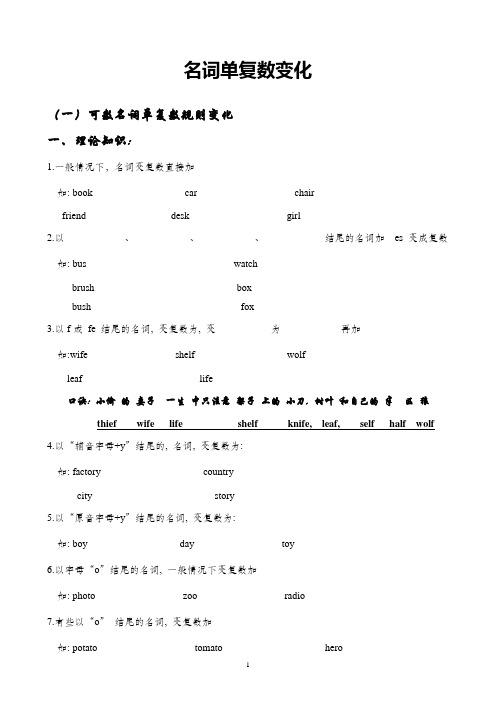
名词单复数变化(一)可数名词单复数规则变化一、理论知识:1.一般情况下,名词变复数直接加____________如: book ______ _______ car _______ _______ chair _______ _____friend ______ ______ desk ______ _____ girl ______ ______2.以___________、___________、___________、___________ 结尾的名词加_es 变成复数如: bus ________ ________ watch ________ ________brush ________ ________ box ________ ________bush ________ ________ fox ________ ________3.以f或fe 结尾的名词, 变复数为, 变__________为__________ 再加__________如:wife ______ ______ shelf ______ _______ wolf ______ ______leaf ________ ________ life ________ ________口诀: 小偷的妻子一生中只注意架子上的小刀, 树叶和自己的半匹狼thief wife life shelf knife, leaf, self half wolf 4.以“辅音字母+y”结尾的, 名词, 变复数为: ________________________________如: factory ________ ________ country ________ ________city ________ ________ story ________ ________5.以“原音字母+y”结尾的名词, 变复数为: ________________________________如: boy _______ ______ day ______ ______ toy ______ ______6.以字母“o”结尾的名词, 一般情况下变复数加________________如: photo ______ ______ zoo ______ ______ radio ______ ______7.有些以“o”结尾的名词, 变复数加________________如: potato _______ _______ tomato ________ ________ hero ________ ________Negro ________ ________ echo ________ ________(二)可数名词的不规则变化一、理论知识1.变单词本身字母如:foot ________ ________ tooth ________ ________ goose ________ ________ man ________ ________ woman ________ ________ mouse ________ ________ child ________ ________ ox ________ ________2.单复数同行sheep ________ ________ deer ________ ________ fish ________ ________ Chinese________ ________ Japanese ________ ________ Swiss ________ ________ 口诀: 中国人, 日本人还有瑞士人都喜欢吃羊, 鹿, 鱼Chinese Japanese Swiss sheep deer fish4.国人的变化(1) 中、日不变Chinese___________ ___________ Japanese___________ ___________(2) 英、法a 变eEnglishman ___________ ___________ Frenchman ___________ ___________ (3) 其他一律加sGerman ___________ ___________ American ___________ ___________Australian ___________ ___________ Canadian ___________ ___________ (口诀: 中日不变, 英法变, 其他一律加s)5.以下单词是集体名词, 本身就只有复数的形式people 人们glasses 眼镜clothes 衣服police 警察trousers 裤子scissors 剪刀family 家人thanks 感谢compass 圆规shoes 鞋子socks 袜子写出下列名词的复数形式, 并写出各词的汉语意思watch ______ ______boy______ ______shoe______ ______student ______ ______ girl ______ ______ leg ______ ______ cup ______ ______ train ______ ______ shelf ______ ______ fox ______ ______ brush ______ ______ class ______ ______ map ______ ______ roof ______ ______ tool ______ ______ tree ______ ______ potato ______ ______ piano ______ ______ holiday ______ ______ Negro ______ ______ chief ______ ______ mouth ______ ______ piece ______ ______ year ______ ______ way ______ ______ body ______ ______ banana ______ ______ watch ______ ______ factory ______ ______ library ______ ______ chair ______ ______ tomato ______ ______ brush ______ ______ monkey ______ ______ dress ______ ______ match ______ ______ orange ______ ______ wife ______ ______ belief ______ ______ party ______ ______ Chinese ______ ______ hero ______ ______ park ______ ______ railway ______ ______ word ______ ______ reef ______ ______ Frenchman ______ ______ sheep ______ ______ tooth ______ ______ photo ______ ______ university ______ ______ brief ______ ______ glass ______ ______ teacher ______ ______ hand ______ ______ foot ______ ______ mouse ______ ______ shirt ______ ______ apple ______ ______ deer ______ ______German ______ ______ Englishman ______ ______ fish ______ ______ Negro ______ ______ family ______ ______ skirt ______ ______ piano ______ ______ month ______ ______ serf ______ ______ giraffe ______ ______ radio ______ ______ chimney ______ ______ train ______ ______ station ______ ______ house ______ ______ classroom ______ ______ office ______ ______ monkey ______ ______ baby ______ ______ leaf ______ ______ kite ______ ______ knife ______ ______ proof ______ ______ reef ______ ______ story ______ ______ thief ______ ______ brother ______ ______名词单复数变化练习用所给词的适当形式填空1.My parents are all ___________ (teacher).2.The desk has four ___________ (leg).3.There are many ___________ (sheep) on the hill.4.A dog has four ___________ (foot).5.There are twelve ___________ (month) in a year and seven ___________ (day) in a week.6.How many ___________ (tomato) are there in the fridge?7.There are three ___________ (apple) and two ___________ (egg) on the plate.8.These black ___________ (mouse) look terrible.9.There are four ___________ (person) in my family.10.We are ___________ (Chinese).They are ___________ (American).11.The little boy has four ___________ (tooth).12.Lily and Lucy are ___________ (Japanese).13.Why do you bring two ___________ (knife) with you?14.Jim and Mary are from different ___________ (country), they are four ___________ (class) from Monday to Friday.15.There are many ___________ (tree) on either side of the street.16.There are fifty ___________ (state) in the USA.17.Can you another two ___________ (cake)?18.How many ___________ (family) are there in the village?19.Seven ___________ (student) are taking ___________ (photo) over there.20.I have four ___________ (watch).21.The ___________ (German) are going to Paris.22.These ___________ (child) are ___________ (Englishman).23.Shanghai is one of the biggest ___________ (city) in China.24.The ___________ (leaf) turn yellow in autumn.25.There are four ___________ (season) in a year and three ___________ (month) in a season.26.There are thirty ___________ (boy) and twenty ___________ (girl) in the class.27.I have one _________ (mouth), two ________ (eye), and two _________ (foot).28.The ___________ (policeman) are in the station.29.We took many ___________ (photo) in the park.30.There are not many ___________ (fish) in the river.31.I want to be a ___________ (scientist) in the future.32.We have many ___________ (book) on the desk.33.This pair of ___________ (glass) is too small for me.34.Please give my best ___________ (wish) for your parents.35.These ___________ (photo) are old.36.Those ___________ (child) are lovely.37.The ___________ (hero) are ___________ (German).38.There are two ___________ (factory) near my home and two thirds of the workers are ___________ (Chinese).39.The ten ___________ (question) are hard to work out.40.There are twenty-four ___________ (hour) in a day.41.The two ___________ (man) are ___________ (Englishman).42.There are many ___________ (sheep) and ___________ (deer) on the grass.43.Here are three ___________ (goose).There are many ___________ (ox).44.I am thirsty.Please give me four ___________ (glass) of drink.45.There are a lot of ___________ (bus) in the street.46.My parents have two ___________ (child).47.The old man’s sisters are ___________ (Australian).48.The little girl has two ___________ (pen).49.I received two ___________ (letter) yesterday.50.They have many ___________ (child), but none of them likes to wash ___________ (dish).51.Six of them are ___________ (worker), but Mr.Liu and Mr.Li are ___________ (postman).52.How many ___________ (radio) are there in the room?53.This passage has four ___________ (part).54.The two ___________ (boy) are my ___________ (friend).55.These ___________ (student) are our ___________ (classmate).最好的friend 朋友from 来自question 问题补充词汇:bestbig 大的small 小的police 警察fifty 五十Monday 星期一Friday 星期五side 边either 两者之一letter 信knife 小刀twelve 十二person 人future 将来scientist 科学家work out 算出lovely 可爱的postman 邮递员part 部分radio 收音机classmate 同学parents 父母亲bring 带来station 车站factory 工厂leg 腿different 不同的leaf 树叶third 第三hill 小山country 国家yellow 黄色的grass 草地these 这些cake 蛋糕autumn 秋天thirsty 渴的those 那些state 州season 季节receive 收到fridge 冰箱village 村庄thirty 三十yesterday 昨天。
英语名词单复数变化规律及练习题

名词单数变复数规则规则变化1)一般情况下加-s如book--books(书)desk--desks(书桌)2)以s ,x ,ch , sh结尾加-es如box--boxes(盒子)bus--buses(公共汽车)brush--brushes watch--watches注意①以th 结尾加-s, month--months②stomach--stomachs3)以辅音字母+结尾,变y为i再加- es。
如city--cities(城市) country--countries(国家)baby-babies婴儿family--families家庭注意以元音+y,直接加s。
如:day--days(天),boy--boys(男孩)4)以f或fe结尾,复数变f或fe 为v再加-es如knife-knives(书) , half-halves(一半) leaf---leaves树叶(thief ,wife ,life ,shelf ,knife ,leaf ,self ,half ,wolf)注意①有少数词后直接加s,如roof-roofs (屋顶)5)以o结尾分2类(1)o结尾的加-es如tomato-tomatoes(西红杮) potato-potatoes(土豆) hero-heroes(英雄)(2) o结尾名词的加-s如piano-pianos (钢琴), zoo-zoos(动物园)photo-photos (照片), kangaroo-kangaroos(袋鼠)kilo-kilos(千克)注意zero 两种方式都可:zero-zeros或zeroes(零)不规则变化1) 元音字母发变化。
如man--men(男人) ,woman--women(妇女)tooth--teeth(牙齿) ,foot--feet(脚)mouse--mice(老鼠) ,policeman--policemen(警察)policewoman--policewomen(女警察)2) 词尾发生变化。
(完整版)可数名词单数变复数规则及练习含答案

可数名词单数变复数规则及练习(含答案)名词可以分为可数名词与不可数名词,其中可数名词具有单复数的形式;而不可数名词没有可数名词复数变化规则如下:1.一般情况下,直接加-s,如:book-books, bag-bags, cat-cats, bed-beds 2.以s. x. sh. ch结尾,加-es,如:bus-buses, box-boxes, watch-watches3.以“辅音字母+y”结尾,变y为i, 再加-es,如:family-families, strawberry-strawberries4.以“f或fe”结尾,变f或fe为v, 再加-es,如:knife-knives5.以o结尾,有生命的加es, 无生命的加s. 如:potato-potatoes. zoo-zoos 6.不规则名词复数:man-men, woman-women, policeman-policemen, policewoman-policewomen, mouse-micechild-children, foot-feet,. tooth-teeth, fish-fish, sheep-sheep people-people, Chinese-Chinese, Japanese-Japanese,当people后加上s时即peoples表示“民族”例如There are 56 peoples in China.以下词为常为不可数名词,他们的复数形式就是他们本身。
water(水) milk(牛奶) tea(茶) rice(米饭) orange(橙汁)juice(果汁)bread (面包)不可数名词的数量关系可借助量词表示,如。
a cup of tea two cups of tea名词复数练习题1).填入所给名词的正确形式1. I have two_____ (knife)2. There are many _____ here. (box)3. There are many _____ on the road. (bus)4. A few ____boys_ are drawing on the wall. (boy)5. The _childen____ are playing football now. (child)2)选择填空1. They come from different ______A. countryB. countriesC. a countryD. countrys2. How many ______ do you see in the picture?A. tomatosB. tomatoesC. tomatoD. the tomato3. There are some ______ in these _______.A.knifes…pencil-boxesB.knives…pencils-boxC.knives…pencil-boxD.knives…pencils-boxes4. There is no ______ in the plate.A. applesB. orangesC. riceD. eggs5. _______ are good for our health.A. TomatosB. TomatoesC. Tomato6. I like to eat cake with ______.A. cherriesB. cherryC.cherrys7. ______ and ______ are not friends.A. Foxs…wolfsB.Foxes wolfsC.Foxes…wolves8. Do you want to drink much ?A.a milkkks9. This is room. It’s very big.A.Lily and Lucy’sB.Lily’s andLucy’s C.Lily’s and Lucy10. Do you want some for supper?A、a potatoB、potatoesC、potatos11. In autumn,you can see a lot of on the ground.A、leafB、leafsC、leaves12. My sister has two . One is old,the other is new.A、a watchB、watchsC、watches13.There on the wall .They are very beautiful.A. are photoesB. are photosC. is a photoD. is photos14. That’a art book.A. anB. aC. the D are15. There two in the box.A. is watchB. are watchesC. are watchD. is watches 3)请用括号中名词的复数形式填空1. Look at those _______. (child)2. I can see a __________ standing near the door. (policeman)3. Do you want some ________ for dinner? (potato)4. In autumn, you can see a lot of _______ on the ground.(leaf) 5. He has two _______.One is blue , the other is yellow.( box)6. Two ________ live in this building .( family )4)选择正确的词形1. How many (radioes, radios) can you see?2. There are 36 (boys, boies) in my class.3. Look at those (sheeps, sheep).4.I don’t want (a, an) old cup.5. Give me that (box, boxes), please.5)将以下单复数句进行转换1.This is a knife.___________________________________2.That is a tomato.___________________________________3.That child is very good.___________________________________4 .These are mice.___________________________________5.Those are children.___________________________________答案1.knives boxes buses boys children2.BBDCB ACBAB CCBAB3.Children policeman potatoes leaves boxes families4.Radios boys sheep an5.These are knives.Those are tomatoes.Those children are very good.This is rice.That is child.。
小升初英语名词变复数语法讲解及专题训练含答案
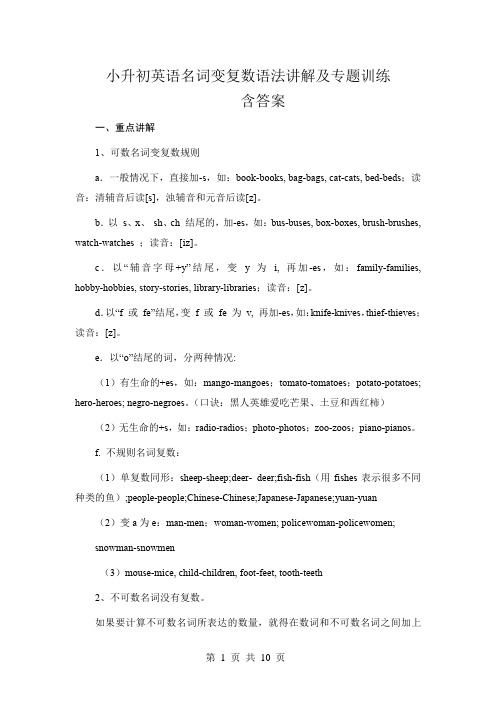
小升初英语名词变复数语法讲解及专题训练含答案一、重点讲解1、可数名词变复数规则a.一般情况下,直接加-s,如:book-books, bag-bags, cat-cats, bed-beds;读音:清辅音后读[s],浊辅音和元音后读[z]。
b.以s、x、sh、ch 结尾的,加-es,如:bus-buses, box-boxes, brush-brushes, watch-watches ;读音:[iz]。
c.以“辅音字母+y”结尾,变y 为i, 再加-es,如:family-families, hobby-hobbies, story-stories, library-libraries;读音:[z]。
d.以“f 或fe”结尾,变f 或fe 为v, 再加-es,如:knife-knives,thief-thieves;读音:[z]。
e.以“o”结尾的词,分两种情况:(1)有生命的+es,如:mango-mangoes;tomato-tomatoes;potato-potatoes; hero-heroes; negro-negroes。
(口诀:黑人英雄爱吃芒果、土豆和西红柿)(2)无生命的+s,如:radio-radios;photo-photos;zoo-zoos;piano-pianos。
f. 不规则名词复数:(1)单复数同形:sheep-sheep;deer-deer;fish-fish(用fishes表示很多不同种类的鱼);people-people;Chinese-Chinese;Japanese-Japanese;yuan-yuan (2)变a为e:man-men;woman-women; policewoman-policewomen;snowman-snowmen(3)mouse-mice, child-children, foot-feet, tooth-teeth2、不可数名词没有复数。
名词的复数形式及习题范例

名词的复数形式及习题范例名词的复数形式是指用来表示多个实体或物体的词形。
在英语中,大部分名词的复数形式是通过在词尾加上"s"或"es"来构成的。
然而,也存在一些特殊规则和例外情况。
本文将探讨名词复数形式的构成规则,并提供一些习题范例来帮助读者加深理解。
一、名词复数形式的构成规则:1. 在大部分情况下,只需在名词的词尾加上"s"来构成复数形式。
例如:- book → books (书→ 书籍)- dog → dogs (狗→ 狗们)- car → cars (汽车→ 汽车们)2. 若名词的词尾是"ch"、"sh"、"s"、"x"或"z",则需要加上"es"。
例如:- watch → watches (手表→ 手表们)- bush → bushes (灌木丛→ 灌木丛)- gas → gases (气体→ 气体们)- box → boxes (盒子→ 盒子们)- quiz → quizzes (测验→ 测验)3. 名词的词尾是辅音字母+y时,将"y"变为"i",再加上"es"。
例如:- city → cities (城市→ 城市们)- baby → babies (婴儿→ 婴儿们)- fly → flies (苍蝇→ 苍蝇们)4. 名词的词尾是元音字母+y时,只需加上"s"。
例如:- day → days (天→ 天数)- boy → boys (男孩→ 男孩们)- key → keys (钥匙→ 钥匙们)5. 若名词的词尾是"f"或"fe",则通常将"f"或"fe"变为"ves"。
初中英语名词单复数专项讲解与练习

初中英语名词单复数专项讲解与练习1. 名词的基本概念名词是指表示人、事物和抽象概念的词语。
在英语中,名词有单数和复数两种形态,单数用来表示一个人或一个事物,复数则表示多个人或多个事物。
2. 名词单数变复数规则常见的名词单数变复数规则有以下几种:2.1 一般在名词后面加-s大多数名词直接在后面加-s构成复数形式,例如:•book(书)→ books(书籍)•cat(猫)→ cats(猫咪)•dog(狗)→ dogs(狗狗)2.2 以-s、-sh、-ch、-x或-z结尾的名词,在后面加-es以-s、-sh、-ch、-x或-z结尾的名词,在复数形式中需要加-es,例如:•bus(公交车)→ buses(公交车)•brush(刷子)→ brushes(刷子)•watch(手表)→ watches(手表)2.3 以辅音字母+y结尾的名词,在-y变-i,再加-es以辅音字母+y结尾的名词,要将-y变为-i,再加-es构成复数形式,例如:•city(城市)→ cities(城市)•baby(婴儿)→ babies(婴儿)2.4 以元音字母+y结尾的名词,在后面直接加-s以元音字母+y结尾的名词,直接在后面加-s构成复数形式,例如:•day(天)→ days(天)3. 名词复数变单数规则将名词由复数形式变为单数形式,需要根据复数的结尾进行相应的规则变化,常见的规则有以下几种:3.1 一般名词复数变单数形式,去除复数词尾-s或-es•books(书籍)→ book(书)•buses(公交车)→ bus(公交车)•watches(手表)→ watch(手表)3.2 以-s、-sh、-ch、-x或-z结尾的名词,去除词尾-es•buses(公交车)→ bus(公交车)•brushes(刷子)→ brush(刷子)•watches(手表)→ watch(手表)3.3 以辅音字母+i结尾的名词,将-i变为-y•cities(城市)→ city(城市)•countries(国家)→ country(国家)•families(家庭)→ family(家庭)4. 名词单复数的特殊情况4.1 不变名词有些名词在单数和复数形式中拼写完全相同,没有任何变化,例如:•deer(鹿)→ deer(鹿)•sheep(羊)→ sheep(羊)4.2 外来词一些外来词的复数形式是直接使用原词,不做任何变化,例如:•piano(钢琴)→ pianos(钢琴)•radio(收音机)→ radios(收音机)4.3 沿袭巴士原型的复数形式一些名词的复数形式并不遵循一般规则,而是沿用巴士原型的复数形式,例如:•child(孩子)→ children(孩子)•mouse(老鼠)→ mice(老鼠)练习题1.将以下名词变成复数形式:•pencil•box•family•potato•bookshelf2.将以下名词变成单数形式:•cats•buses•houses•babies•watches答案:1.pencils•boxes•families•potatoes•bookshelves2.cat•bus•house•baby•watch以上是对初中英语名词单复数的专项讲解与练习,希望能帮助到你。
名词变复数的规则及习题
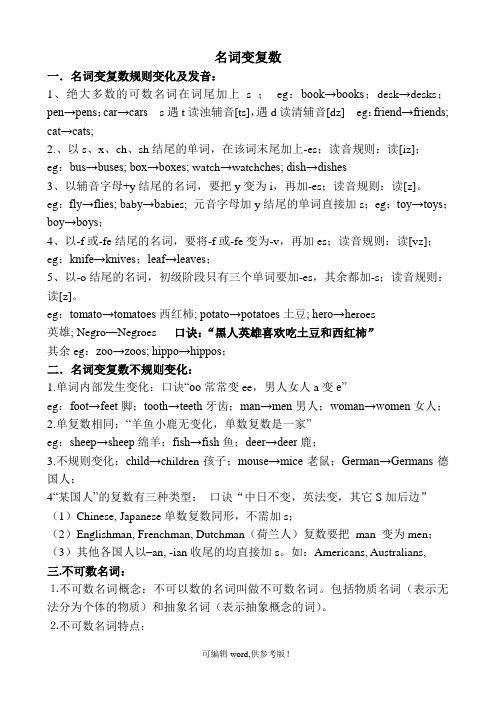
名词变复数一.名词变复数规则变化及发音:1、绝大多数的可数名词在词尾加上s ;eg:book→books;desk→desks;pen→pens;car→cars s遇t读浊辅音[ts],遇d读清辅音[dz] eg:friend→friends; cat→cats;2.、以s、x、ch、sh结尾的单词,在该词末尾加上-es;读音规则:读[iz];eg:bus→buses; box→boxes; watch→watch ches; dish→dishes3、以辅音字母+y结尾的名词,要把y变为i,再加-es;读音规则:读[z]。
eg:fly→flies; b ab y→b abies; 元音字母加y结尾的单词直接加s;eg:toy→toys;boy→boys;4、以-f或-fe结尾的名词,要将-f或-fe变为-v,再加es;读音规则:读[vz];eg:knife→knives;leaf→leaves;5、以-o结尾的名词,初级阶段只有三个单词要加-es,其余都加-s;读音规则:读[z]。
eg:tomato→tomatoes西红柿; potato→potatoes土豆; hero→h eroes英雄; Negro—Negroes 口诀:“黑人英雄喜欢吃土豆和西红柿”其余eg:zoo→zoos; hippo→hippos;二.名词变复数不规则变化:1.单词内部发生变化:口诀“oo常常变ee,男人女人a变e”eg:foot→feet脚;tooth→teeth牙齿;man→men男人;woman→women女人;2.单复数相同:“羊鱼小鹿无变化,单数复数是一家”eg:sheep→sheep绵羊;fish→fish鱼;deer→deer鹿;3.不规则变化:child→c hildren孩子;mouse→mice老鼠;German→Germans德国人;4“某国人”的复数有三种类型:口诀“中日不变,英法变,其它S加后边”(1)Chinese, Japanese单数复数同形,不需加s;(2)Englishman, Frenchman, Dutchman(荷兰人)复数要把man 变为men;(3)其他各国人以–an, -ian收尾的均直接加s。
名词变复数规则及练习题

可数名词变复数规则变化1.一般名词复数是在名词后面加上“s”,如map→maps,bag→bags等;2.以s,sh,ch,x等结尾的词加“es”,如bus→buses,watch→watches等;3.以辅音字母+y结尾的词,变y为i加es,如baby→babies等;以元音字母+y结尾的名词变复数时,直接加s变复数,如monkey→monkeys,4.以o 结尾的名词变复数时:a)加s的名词有:photo→photos 照片,piano→pianos钢琴,radio→ra dios收音机,b)加es的名词有:potato→potatoes土豆tomato→tomatoes 西红柿5.以f或fe结尾的名词变复数时,去掉f,fe 加ves:knife→knives刀leaf→leaves树叶wolf→wolves狼wife→wives妻子名词复数的不规则变化1)child---children 孩子(们)foot---feet脚tooth---teeth 牙齿mouse---mice老鼠man---men男人woman---women 女人2)单复同形如:deer,sheep,fish,Chinese,Japaneseli,jin,yuan,two li,three mu,four jin3)集体名词,以单数形式出现,但实为复数。
如:people人police警察等本身就是复数,不能说 a people,a police,但可以说a person一个人,a policeman一个警察4) 表示由两部分构成的东西,如:glasses (眼镜) trousers,裤子clothes衣服若表达具体数目,要借助数量词pair(对,双); suit(套); a pair of glasses; two pairs of trousers5)另外还有一些名词,其复数形式有时可表示特别意思,如:goods货物,waters水域,fishes(各种)鱼---鱼当种类讲时有复数形式,当几条鱼时无复数。
小学英语语法名词单复数变化规律原则及名词时态变化专项练习题和答案

语法专项练习--名词单复数用法+练习题+答案一、名词:表示某一事物的名词。
1.专有名词:人名,地名,机构等专有的名称,如Beijing、China等。
2.普通名词:①可数名词:可以用数目来计算的具体的个体名词和集体名词。
②不可数名词,无法用数目计算的物质名词和抽象名词。
二、名词变复数(可数名词变复数)1、原理:be 动词如果是am、is或was,名词就用原形;be动词如果是are或were,名词就加s或es。
注意:不可数名词都默认为单数,所以总是用is或者was;最好不要根据 some、any、alot of等作判断,以免受误导。
2、如何加后缀:①一般情况下,直接加-s,如:book-books,bag-bags,cat-cats,bed-beds②以s.x.sh.ch结尾,加-es,如:bus-buses,box-boxes,brush-brushes, watch-watches③以“辅音字母+y”结尾,变y为i,再加-es,如:family-families,strawberry-strawberries④以“f或fe”结尾,变f或fe为v,再加-es,如:knife-knives⑤以元音字母+y结尾的名词变复数时,直接加s变复数,如:monkey---monkeys holiday---holidays⑥以o结尾的名词,变复数时:加s,如:photo---photos zoo---zoos加es如:potatoes,tomatoes⑦不规则名词复数:fish-fish,man-men,woman-women,policeman-policemen,policewoman-policewomen,foot-fe et,child-children tooth-teeth,people-people,Chinese-Chinese,Japanese-Japanese,mouse-mice注意:1)单复同形如:deer,sheep,fish Chinese Japanese 2) 集体名词,以单数形式出现,但实为复数。
名词变复数规则(共五则)
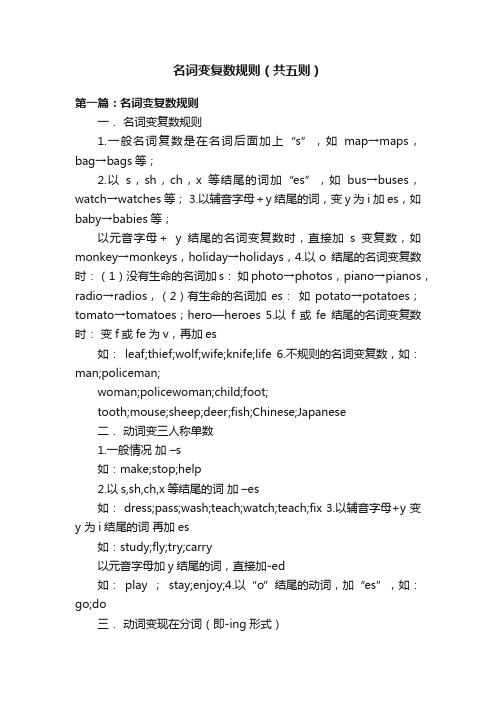
名词变复数规则(共五则)第一篇:名词变复数规则一.名词变复数规则1.一般名词复数是在名词后面加上“s”,如map→maps,bag→bags等;2.以s,sh,ch,x等结尾的词加“es”,如bus→buses,watch→watches等;3.以辅音字母+y结尾的词,变y为i加es,如baby→babies等;以元音字母+y结尾的名词变复数时,直接加s变复数,如monkey→monkeys,holiday→holidays,4.以o 结尾的名词变复数时:(1)没有生命的名词加s:如photo→photos,piano→pianos,radio→radios,(2)有生命的名词加es:如potato→potatoes;tomato→tomatoes;hero—heroes 5.以f或fe结尾的名词变复数时:变f或fe为v,再加es如:leaf;thief;wolf;wife;knife;life 6.不规则的名词变复数,如:man;policeman;woman;policewoman;child;foot;tooth;mouse;sheep;deer;fish;Chinese;Japanese二.动词变三人称单数1.一般情况加–s如:make;stop;help2.以s,sh,ch,x等结尾的词加–es如: dress;pass;wash;teach;watch;teach;fix 3.以辅音字母+y 变y 为i结尾的词再加es如:study;fly;try;carry以元音字母加y结尾的词,直接加-ed如:play ;stay;enjoy;4.以“o”结尾的动词,加“es”,如:go;do三.动词变现在分词(即-ing形式)1.一般情况,加-ing如:go;ask;look;watch2.以不发音的e结尾的动词,去e,再加-ing如: write;make;take;practice;3.以重读闭音节结尾的动词,末尾只有一个辅音字母,双写这个辅音字母,再加-ing如:get;sit;run;put;begin;swim;stop;plan;shop四.动词变过去式1.一般情况,加-ed如:look;play;start;listen 2.以e结尾的动词,加-d如: hope;use;live;decide3.以重读闭音节结尾的动词,末尾只有一个辅音字母,双写这个辅音字母,再加-ed 如:stop;plan;shop4.以辅音字母加y结尾的动词,变y为i,再加-ed如:study;carry;worry;try;第二篇:名词变复数中考题名词单复数中考习题集锦【2013四川遂宁】22.I’m so hungry.Please give me ______ to eat.A.three bread B.three pieces of bread C.three pieces of breads 【答案】B 【解析】考查不可数名词数量的表示。
(word完整版)初中英语名词单复数专项讲解与练习
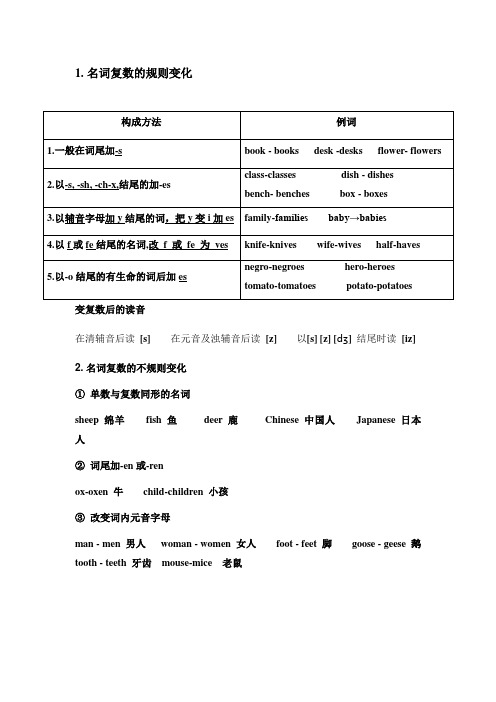
1.名词复数的规则变化变复数后的读音在清辅音后读[s] 在元音及浊辅音后读[z] 以[s] [z] [dʒ] 结尾时读[iz]2. 名词复数的不规则变化①单数与复数同形的名词sheep 绵羊fish 鱼deer 鹿Chinese 中国人Japanese 日本人②词尾加-en或-renox-oxen 牛child-children 小孩③改变词内元音字母man - men 男人woman - women 女人foot - feet 脚goose - geese 鹅tooth - teeth 牙齿mouse-mice 老鼠一. 名词单数变复数填空1.orange text bed cakecomputer apple house quilt plane tree lesson banana shirt month cup parent 2.piano photo radio zootomato potato hero negro 3.class fox watch glassdress brush box bus 4.shelf knife wife lifeleaf thief wolf5.family country army city story baby butterfly6.toy day key boy7.sheep fish deer Chinese8.child ox man womanfoot goose tooth mouse 二.代词/ be动词单数变复数this ______ that _________ I _______ you ________she_______ he ________ it ________ am _____ is _______三:把下列的单词变为复数形式1.key2.boy3.family4.case5.backpack6.dictionary7.watchputer 9.game 10.notebook 11.bag 12.math 13.alarm 14.video 15.tape 16.hat 17.pear 18.egg 19.apple 20.carrot 21.vegetable22.star 23.sock 24.shirt 25.shoe 26.skirt 27.sweater 28.clerk29.store 30.shop_________四:句子单数变复数1.This is a book. . __________________________2.That is an eraser. ___________________________3.It is a red apple. ____________________________4.I am a boy. ______________________________5.He / She is a teacher. __________________________6.What’s this? _________________________________五:名词复数变单数练习1:Those are my friends._________________________ 2: They are English boys. __________________________ 3: They are some erasers. ________________________ 4: These are dictionaries. ___________________________ 5: we are students. ___________________________6: what color are your books ? ______________________ 六:根据句意及所给单词填空。
